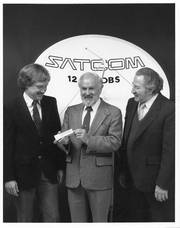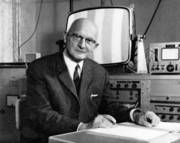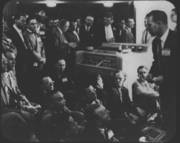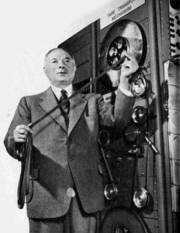Zum Auffrischen und Schmunzeln . . .
. . . sind diese Museums-Seiten hier gedacht, denn viele wissen nicht mehr oder noch nicht, wie es damals angefangen hat und wie das wirklich funktioniert mit den Tonband- und den Magnetbandgeräten aus alter Zeit. Viele Bilder können Sie durch Anklicken vergrößern, auch dieses.
Zwei Artikel aus 1976 - von Joe Roizen, einem der wenigen fachlich anerkannten Spezialisten.
Die Revolution durch den Video-Recorder 1956 - Teil 1
Ein Rückblick auf die Geschichte und die kreativen Geister.
The annals of science and industry are littered with the writings of two types of people, the thinkers and the doers. While conception obviously predates construction, there is no shortage of instances where the conception alone, although recorded in some periodical, is not reduced to practice and someone else, either simultaneously or at a later date, finally creates the device in question.
Video recording also had its thinkers and a diligent search of old patents and long forgotten books yields a few of these early concepts. It almost seems as if one searched far enough, one could find a crude drawing made by Leonardo da Vinci proposing a means of committing images to a medium.
The earliest chronological proposal for the use of magnetic recording to store pictures was found by the author in a book titled, "Handbuch der Bildtelegraphie und des Fernsehens" which was published in Germany in 1932, and which describes a series of schemes for picture telegraphy proposed by Dr. Fritz Schroeter, professor at the Berlin Technischen Hochschule and a director of Telefunken. The illustrations in the book quite clearly resemble present day transverse and helical scanning formats which are used currently for video recording on tape.
Some of these proposals date back to the late twenties, a period during which the British patent office also issued a patent to Boris Ritcheouluff of London who designed a picture recorder of considerable ingenuity based on the Valdemar Poulsen machine developed in Denmark at the turn of the century.
In 1938, an Italian inventor by the name of Luigi Marzocci filed a patent application for a variety of rotary head recorders which were clearly intended for sound recording and so labelled in the patent. Nevertheless, the drawings are so amazingly similar to the arcuate and transverse video recording concepts which came later that the company which held the rights to Marzocci's invention were prompted to consider legal action against Ampex after they commercialized their VTR.
Even as the Ginsburg group were developing the transverse recorder, a German engineer by the name of Eduard Schueller, working in Hamburg for Telefunken, filed for a patent on the 30th of June 1953 covering a two head helical recorder that is almost identical in concept to a few of the machines that were later produced in America, Japan and Germany.
Die Vorbereitung des 14. April 1956
There was an air of normal conviviality among the 200 station owners and managers attending the CBS television affiliates meeting that preceded the opening of the NAB (National Association of TV Broadcasters) convention in the Conrad Hilton Hotel in Chicago. As the delegates filed into the Normandy Lounge to listen to their headquarters manager, William Lodge deliver the annual report, they had no thinking that this April 14, 1956 meeting would expose them to one of the most unusual technical developments which would significantly alter television from that day forward.
It was not out of the ordinary at such gatherings to have a camera pointed at the podium and a few monitors set up in the room so as to convey the aura of television. If any of those in attendance noticed an unfamiliar high pitched whine, they probably assumed that it was due to a faulty fluorescent lamp or some external machinery. Bill Lodge made his prepared presentation with what seemed like a pregnant pause at the end.
Die perfekte Überraschung der Experten gelang
Suddenly, the monitors in the room were showing what must have seemed to the audience as an impossibility, for they were looking at an instant playback of the Lodge speech, with an image clarity indistinguishable from the original they had seen a few minutes earlier. There was a hushed silence as those in the room tried to relate this assult on their senses, with their a priori knowledge that TV images could not be immediately repeated by any known device.
As the impact of what was happening before them sank in, the silence was broken by an equally sudden roar of applause, cheers, whistles, and stamping of feet.
The curtain behind the podium opened to reveal a large gray console that looked like a gargantuan audio tape recorder, with overgrown reels of tape on its horizontal top plate. Hovering over this whirring magnetic monster, with looks of obvious relief, were a few of the engineers responsible for developing it.
With the presentation over, the normally staid and dignified executives from television stations all over the country crowded in around the VTR, trapping the operating personnel against the machine, while they pushed, elbowed and stood on chairs to get a glimpse of this latest video marvel.
The VTR crew, who just a few minutes earlier were holding their breath in the fond hope that this hastily assembled contraption of infinite electro-mechanical complexity would perform on cue, were now busily answering questions from excited interrogators who were naturally curious about performance, price and availability.
Harte Arbeit mit vielen Rückschlagen ging voraus
The prearranged plan had been to record the output of the monochrome camera covering Bill Lodge up to a certain cue point, then the Machine was rewound and put into the "play" mode just as Lodge's comments ended. There was no available monitor for the team behind the curtain to check the playback before punching it up on the TV screens in the other part of the room. As a result, they had to operate on the blind faith that everything was working well. That short silence at the beginning of the playback seemed like an eternity to Ginsburg, Dolby, Anderson and Pfost, four of the key members of the Ampex engineering team.
All the hardships, the concentrated efforts, the endless hours of work, and the frequent disappointments were suddenly swept away in the euphoria of success which triggered off an avalanche of videotape recorders that now permeate the entire television world and represent a billion dollar plus industry.
In the four days following, this small California-based company wrote orders for $4,000,000 worth of their magnetic miracle, which represent one of the most expensive recording devices ever made selling at approximately $50,000. Nevertheless, its obvious benefit to TV operations, at least in the program delay category, was sufficiently attractive to warrant the huge investment that the major networks hastily committed in order to equip themselves with VTR's.
Extending Known Principles
While all of these esoteric prognostications had technical merit, they were too far ahead of existing tape and head technology to warrant much attention from serious experimenters in the field. Instead, the major efforts at that time (late forties, early fifties were directed toward extensions of the known principles of magnetic audio recording by extrapolating those operating parameters into the region of video signals.
Four such known projects were going on, the best publicized one being at the RCA laboratories in New Jersey. Under the direction of Dr. Harold Olson, a man with an excellent reputation in the field of acoustics, a team of researchers built and demonstrated a series of longitudinal, high speed VTR's that made monochrome and color pictures.
1953 - Die RCA Entwicklung war nicht erfolgreich . . .
The first laboratory prototype shown publicly in 1953 used tape one-half inch wide and ran at 30 feet/sec. There were five tracks on the tape and a 7,000 foot reel ran for 4 minutes. Subsequently, the tape speed was lowered to 20 feet/ sec. and the playing time raised to 15 minutes. RCA felt confident enough with this advanced machine to make some program demos at NBC in late 1955.
The RCA system reduced the incoming color video signal into its RGB elements, each of which went on a separate track, as did the synchronizing information. The fifth track carried the audio signal which was recorded in FM with a carrier and deviation of 90 kHz and plus/minus 15 kHz respectively. The stationary magnetic heads of one micron gap width could handle frequencies up to 1.5 MHz.
The RCA machine had many innovations that became fairly standard on subsequent VTR's. Tape tension servos, eddy current brakes, luminance/chrominance separation and sync reinsertion, familiar techniques today, were all part of these early recorders.
. . . die Crosby Entwicklung war auch nicht erfolgreich -
Clear across the country, in a well equipped lab on Sunset Blvd. in Los Angeles, another VTR project was under way, under the sponsorship of Bing Crosby. The famous singer's early relationship with the Ampex audio recorder and its rapid rise in popularity must have given him the idea that a similar breakthrough in video would be tremendously profitable. With the help of his brother (who was also his business manager), they set up Crosby Enterprises and hired John Mullin to head up a group of engineers who were to pursue yet another technical approach.
The basic theory was to use division multiplexing with 10 channels covering the split up of the desired video frequency range. A bandwidth of 17 kHz per channel produced a cumulative spectrum of 1.7 MHz, adequate for monochrome reproduction. Sync was recorded on an eleventh track to avoid the distortion effects of the band separation filters.
By 1952 Crosby Enterprises were inviting broadcasters in to look at credible results of off air black and white recordings. There were, however, some severe picture impairments that would require much improvement before the recorder could be considered acceptable to broadcasters. After transverse video recording was introduced, the Crosby project was acquired by the 3M Company as their Mincom Division and was put to other recording tasks in the instrumentation field.
. . . die BBC "VERA" Entwicklung in England auch nicht.
The BBC also saw the potential advantage of a vision magnetic recorder, and in 1952 assigned Dr. Peter Axon to lead a long-term effort in this direction. The machine was called VERA (Vision Electronic Recording Apparatus) and was quite different from its contemporaries. Many of the developments achieved in this recorder served as departure points for subsequent helical VTR's that were developed later.
The half-inch tape moved at 16 feet/sec, and a 21-inch diameter reel gave 15 minutes of playing time. VERA was capable of a 3 MHz bandwidth, a significant achievement for its era in longitudinal recording. The fundamental approach was to separate the video signal into two bands: the first for all low frequencies up to 100 kHz, the second from 100 kHz to 3 MHz. Low frequencies were recorded by FM techniques while the highs were applied to the tape in AM form. The carrier of 700 kHz was modulated upward for sync pulses and downward for peak whites (the opposite of most present systems) and was deviated by plus/ minus 300 kHz.
In playback, the two separate frequency bands were combined to produce an image good enough to put on the air in 1958. VERA had many unique features, among the most notable being heads made of ferrite cores clad with permalloy with a gap width of 0.5 microns and a closed loop tape drive system which held tape speed to 0.04% by locking to an external sync generator and comparing the sync off tape with the reference source.
The BBC terminated the project when it became evident that the transverse approach, introduced by Ampex, would become the standard of the industry. As a matter of fact, Dr. Axon also recognized this potential and shortly after became Ampex's managing director of their Reading operation.
Auch die Japaner hatten am VTR gebastelt
The Japanese develope DESSAN.
While little information was coming out of Japan in those early days, it later became evident that several Japanese organizations were also experimenting with videotape recording. The longitudinal effort was called the DESSAN project and was named after an artistic technique which did the broad brush background first (i.e., low frequencies) and filled in the detail later (high frequencies).
In 1953, Toshiba was experimenting with crude helical scan systems, which five years later evolved into both single and dual head prototypes. The presentation of the first Japanese paper by Norikazu Sawazaki of Toshiba on helical recording, at the 1960 SMPTE meeting in Los Angeles, stirred up quite a controversy about the relative merits of basic VTR formats which is still going on. It also caused Ampex to rush to completion an ill-fated two inch helical recorder (the VR8000) which] was shipped in heavily sealed locked boxes to the following NAB convention in Chicago. Flying different aircraft, Ginsburg and Maxey had the only keys to the locks. It was to be demonstrated only if a competitive broadcast recorder, with a helical configuration, was shown. There were none and the black crates were returned to Redwood City unopened.
Lets continue the VTR game
Lets anyone wonder at this cloak and dagger scenario, it should be explained that fortunes were made or lost on Ampex stock, often as a result of rumor or innuendo. When Dr. William Glen of General Electric announced the first thermoplastic recorder, which he claimed would challenge the videotape position in television, the mere possibility caused a run on the market which took several years of subsequent evidence that the process was impractical for Ampex stock to recover.
Videotape recording had become big business, and like its counterparts in other high technology fields, it needed constant R & D to keep it ahead of the game.






